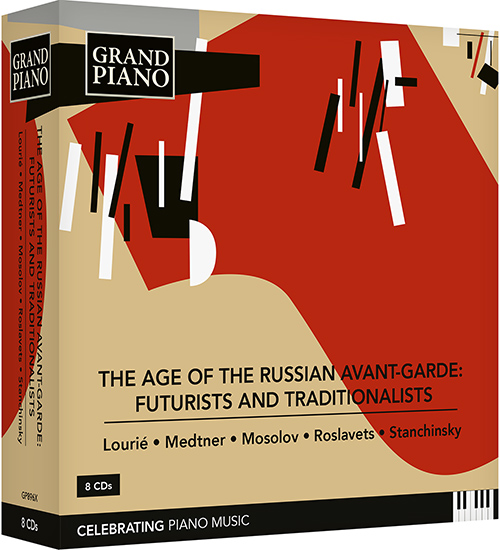
About this Release
AGE OF THE RUSSIAN AVANT-GARDE (THE): FUTURISTS AND TRADITIONALISTS
Lourié • Medtner • Mosolov • Roslavets • Stanchinsky
Modernity in Russian music emerged despite its struggles with the Soviet regime in the early 20th century, with the mystical vision of Scriabin’s musical legacy providing a foundation on which to build. In these acclaimed albums we discover Medtner’s life affirming Sonatas, and hear Lourié’s journey from Impressionism to pioneering Cubist conceptions. Mosolov’s works are bold and complex, while Roslavets new tonal system brings ‘fire and ice’, and Stanchinsky’s sophisticated virtuosity anticipates many aspects of 20th-century style. These remarkable works represent a time of profound change in Russian culture that is still being discovered and assessed today.
Tracklist
|
Stanchinsky, Alexei Vladimirovich
|
|
1
Piano Sonata in E-Flat Minor (1906) (00:10:27)
|
|
Songs without Words (1904) (00:08:00 )
|
|
2
No. 1. Largo (00:02:52)
|
|
3
No. 2. Andante cantabile (00:04:01)
|
|
4
No. 3. — (00:02:10)
|
|
5
Mazurka in D-Flat Major (1905) (00:03:22)
|
|
6
Humoresque (1906) (00:05:01)
|
|
7
Les Larmes (Tears) (1906) (00:01:55)
|
|
10
Nocturne in C-Sharp Minor (1907) (00:05:14)
|
|
2 Preludes (1907) (1907) (00:03:00 )
|
|
9
2 Preludes (1907): No. 1 in C Minor (00:02:29)
|
|
11
2 Preludes (1907): No. 2 in A-Flat Major (00:01:55)
|
|
12
Etude in F Minor (1907) (00:02:31)
|
|
3 Preludes (1907) (00:09:00 )
|
|
8
3 Preludes: No. 1 in C-Sharp Minor (00:02:06)
|
|
13
No. 2 in D Major (00:01:11)
|
|
14
No. 3 in E-Flat Minor (00:02:28)
|
|
15
Etude in G Minor (1907) (00:03:16)
|
|
16
Prelyudiya v lidiyskom ladu (Prelude in the Lydian Mode) (1908) (00:04:21)
|
|
17
Mazurka in G-Sharp Minor (1907) (00:01:43)
|
|
18
Canon in B Minor (1908) (00:01:00)
|
|
19
Prelude in E Major, "Mixolydian" (1908) (00:01:16)
|
|
20
Etude in B Major (1910) (00:06:50)
|
|
2 Preludes (1909) (1909) (00:03:00 )
|
|
21
No. 1 in B-Flat Minor (00:00:58)
|
|
22
No. 2 in B Minor (00:00:35)
|
|
Prelude and Fugue in G Minor (1909) (00:06:00 )
|
|
23
Prelude (00:02:16)
|
|
24
Fugue (00:02:24)
|
|
Roslavets, Nikolay Andreyevich
|
|
1
Piano Sonata No. 1 (1914) (00:12:02)
|
|
3 Compositions (1914) (00:04:00 )
|
|
2
No. 1. Adagio (00:01:08)
|
|
3
No. 2. Agitato con passione (00:00:42)
|
|
4
No. 3. Allegretto grazioso (00:01:35)
|
|
5
Prélude (1915) (1915) (00:03:45)
|
|
2 Sochineniya (2 Compositions) (1915) (00:06:00 )
|
|
6
No. 1. Très modéré (00:02:54)
|
|
7
No. 2. Lent (00:03:47)
|
|
2 Poems (1920) (00:05:00 )
|
|
8
No. 1. Quasi prélude: Allegretto: Fervido (00:02:39)
|
|
9
No. 2. Quasi poème: Moderato (00:03:00)
|
|
10
Piano Sonata No. 2 (1916) (00:13:05)
|
|
3 Études (1914) (00:13:00 )
|
|
1
No. 1. Affettamente (00:05:41)
|
|
2
No. 2. Con dolce maniera (00:02:51)
|
|
3
No. 3. Burlando (00:06:04)
|
|
5 Préludes (1922) (00:11:00 )
|
|
4
Prélude No. 1 (00:01:53)
|
|
5
Prélude No. 2 (00:02:29)
|
|
6
Prélude No. 3 (00:02:51)
|
|
7
Prélude No. 4 (00:01:41)
|
|
8
Prélude No. 5 (00:01:57)
|
|
9
Berceuse (1919) (00:04:08)
|
|
10
Danse (1919) (00:01:50)
|
|
11
Valse (reconstructed by M. Lobanova) (1919) (00:04:31)
|
|
12
Prelude (1919/1921) (reconstructed by M. Lobanova) (1919) (00:01:17)
|
|
4 Compositions (excerpts) (1921) (00:03:03 )
|
|
13
Prélude (00:01:27)
|
|
14
Poème (00:01:42)
|
|
15
Piano Sonata No. 5 (1923) (00:13:16)
|
|
Medtner, Nicolai
|
|
Sonaten-Triade, Op. 11 (1907) (00:22:00 )
|
|
1
No. 1 in A-Flat Major (00:11:04)
|
|
2
No. 2 in D Minor, "Sonata-Elegy" (00:07:22)
|
|
3
No. 3 in C Major (00:10:05)
|
|
Sonata-Skazka in C Minor, Op. 25, No. 1, "Märchen-Sonate" (1911) (00:12:35 )
|
|
4
I. Allegro abbandonamente (00:05:54)
|
|
5
II. Andantino con moto (00:03:43)
|
|
6
III. Allegro con spirito (00:04:02)
|
|
Sonata-Idylle in G Major, Op. 56 (1937) (00:13:00 )
|
|
7
I. Pastorale: Allegretto cantabile (00:04:18)
|
|
8
II. Allegro moderato e cantabile (sempre al rigore di tempo) (00:08:55)
|
|
Lourié, Arthur
|
|
5 Préludes fragiles, Op. 1 (1910) (00:11:00 )
|
|
1
Prelude No. 1: Lento (00:01:50)
|
|
2
Prelude No. 2: Calme, pas vite (00:01:59)
|
|
3
Prelude No. 3: Tendre, pensif (00:01:58)
|
|
4
Prelude No. 4: Affabile (00:01:25)
|
|
5
Prelude No. 5: Modéré (00:02:51)
|
|
2 Estampes, Op. 2 (1910) (00:08:00 )
|
|
6
No. 1. Crépuscule d'un faune (00:04:23)
|
|
7
No. 2. 'Les parfums, les couleurs et les sons se répondent' (00:03:39)
|
|
2 Mazurkas, Op. 7 (1912) (00:05:00 )
|
|
8
No. 1. Lent, languide (00:02:01)
|
|
9
No. 2. Essor (00:03:00)
|
|
4 Poèmes, Op. 10 (1913) (00:10:00 )
|
|
10
No. 1. Spleen (00:03:28)
|
|
11
No. 2. Caprices (00:02:32)
|
|
12
No. 3. Autoportrait (00:02:35)
|
|
13
No. 4. Ironies (00:01:46)
|
|
Formes en l'air (1915) (00:10:00 )
|
|
14
No. 1. — (00:01:59)
|
|
15
No. 2. — (00:02:13)
|
|
16
No. 3. — (00:02:35)
|
|
Masques (1913) (00:19:00 )
|
|
17
No. 1. Nuagé, suave (00:03:20)
|
|
18
No. 2. Caché, avec une ironie suave (00:01:07)
|
|
19
No. 3. Avec une grâce fragile (00:02:16)
|
|
20
No. 4. Dans un mystère profond et calme (00:01:39)
|
|
21
No. 5. Etrange, charmé (00:01:26)
|
|
22
No. 6. Très lent, calme (Mouvement d'un marche funèbre) (00:02:55)
|
|
23
No. 7. Pâmé, avec désir croissant (00:01:28)
|
|
24
Upmann, a Smoking Sketch (1919) (00:03:11)
|
|
Petite Suite in F Major (1924) (00:03:00 )
|
|
25
I. — (00:00:41)
|
|
26
II. — (00:01:08)
|
|
27
III. — (00:00:34)
|
|
28
IV. — (00:00:53)
|
|
29
Dialogue (1930) (00:03:56)
|
|
2 Poèmes, Op. 8 (1912) (00:12:00 )
|
|
1
No. 1. Essor (00:02:05)
|
|
2
No. 2. Ivresse (00:05:16)
|
|
3
Menuett nach Gluck (1914) (00:03:19)
|
|
Sintezï (Synthèses), Op. 16 (1914) (00:11:00 )
|
|
4
No. 1. Lent (00:01:31)
|
|
5
No. 2. Modérément animé (00:01:36)
|
|
6
No. 3. Vite (aigu) (00:01:47)
|
|
7
No. 4. Assez vite, mais toujours mesuré (00:01:15)
|
|
8
No. 5. Mesuré (00:00:59)
|
|
Dnevnoy uzor (Daytime Routine) (1915) (00:11:00 )
|
|
9
No. 1. Étude (Study) (00:01:10)
|
|
10
No. 2. Promenade (Walk) (00:03:18)
|
|
11
No. 3. Ombres (Shadows) (00:02:51)
|
|
12
No. 4. Sorcellerie (Sorcery) (00:02:20)
|
|
13
No. 5. Polissonerie (Mischievousness) (00:01:50)
|
|
Rojal' v detskoj (8 Scenes of Russian Childhood) (1917) (00:11:00 )
|
|
14
No. 1. The porcelain shepherd and his flock (00:01:00)
|
|
15
No. 2. Little trepak (00:01:22)
|
|
16
No. 3. A good boy (00:00:58)
|
|
17
No. 4. A naughty boy (00:01:04)
|
|
18
No. 5. Bogey man (00:01:07)
|
|
19
No. 6. Lullaby (00:02:03)
|
|
20
No. 7. Sun and shower (00:01:53)
|
|
21
No. 8. Children's song: Wlazł kotek na płotek (The Kitten Climbed on the Fence) (00:01:08)
|
|
22
Piano Sonatina No. 3 (1917) (00:03:23)
|
|
23
Toccata (1924) (00:05:08)
|
|
24
Valse (1926) (00:04:10)
|
|
25
Gigue (1927) (00:05:01)
|
|
26
Marche (1926) (00:02:30)
|
|
27
Nocturne (1928) (00:06:56)
|
|
28
Intermezzo (1928) (00:05:53)
|
|
29
Berceuse de la chevrette (1936) (00:03:19)
|
|
30
Phoenix Park Nocturne (1938) (00:05:05)
|
|
Mosolov, Alexander
|
|
1
Piano Sonata No. 1 in C Minor, Op. 3 (1924) (00:10:55)
|
|
2 Nocturnes, Op. 15 (1926) (00:07:00 )
|
|
2
No. 1. Elegiaco, poco stentato (00:03:28)
|
|
3
No. 2. Adagio (00:03:28)
|
|
3 Small Pieces, Op. 23a (1927) (00:02:51 )
|
|
4
No. 1. — (00:00:55)
|
|
5
No. 2. — (00:00:47)
|
|
6
No. 3. — (00:00:43)
|
|
2 Dances, Op. 23b () (00:04:20 )
|
|
7
No. 1. Allegro molto, sempre marcato (00:02:02)
|
|
8
No. 2. Allegretto (00:02:15)
|
|
Piano Sonata No. 2 in B Minor, Op. 4, "Iz starïkh tetradey" (From Old Notebooks) (1924) (00:24:00 )
|
|
9
I. Sonata (00:10:28)
|
|
10
II. Adagio (00:06:38)
|
|
11
III. Final (00:06:29)
|
|
1
Piano Sonata No. 4, Op. 11 (1928) (00:11:46)
|
|
Turkmenian Nights (1929) (00:11:35 )
|
|
2
I. Andante con moto (00:04:07)
|
|
3
II. Lento (00:05:15)
|
|
4
III. Allegro (00:02:19)
|
|
Piano Sonata No. 5 in D Minor, Op. 12 (1925) (00:25:00 )
|
|
5
I. Lento grave (00:05:48)
|
|
6
II. Elegia (00:05:42)
|
|
7
III. Scherzo (00:03:06)
|
|
8
IV. Adagio languente e patetico (00:08:34)
|
The Composer(s)
 Although Lourié studied at the St Petersburg Conservatoire, where his composition teachers included Alexander Glazunov, his main musical influence in his youth was Alexander Scriabin, whose late piano works fascinated him. He was also greatly inspired by the Futurists, and he made musical settings of verses by poets such as Anna Akhmatova (with whom he conducted a passionate affair). Vladimir Mayakovsky and Alexander Blok affected him profoundly through the eloquence of their writing and the allure of their political views, which appealed to Lourié’s own radical disposition. He fully espoused the idea of transforming human consciousness through the kind of spiritual revolution that was the hallmark of the Russian Symbolists.
Although Lourié studied at the St Petersburg Conservatoire, where his composition teachers included Alexander Glazunov, his main musical influence in his youth was Alexander Scriabin, whose late piano works fascinated him. He was also greatly inspired by the Futurists, and he made musical settings of verses by poets such as Anna Akhmatova (with whom he conducted a passionate affair). Vladimir Mayakovsky and Alexander Blok affected him profoundly through the eloquence of their writing and the allure of their political views, which appealed to Lourié’s own radical disposition. He fully espoused the idea of transforming human consciousness through the kind of spiritual revolution that was the hallmark of the Russian Symbolists.  Nikolay Karlovich Medtner was Moscow born-and-bred, although his ancestry was German. As a child he showed musical promise, and studied piano with his mother until his acceptance into the Moscow Conservatory at the age of twelve. Medtner’s teachers during these years included Vasily Safonov for piano, Anton Arensky for harmony and Sergey Taneyev for counterpoint, the latter having a particularly strong influence on his musical development. Taneyev instilled in all his students a respect for the old masters—Palestrina, Bach, Mozart and especially Beethoven—and stressed contrapuntal and structural command as essential to any composer’s craft.
Nikolay Karlovich Medtner was Moscow born-and-bred, although his ancestry was German. As a child he showed musical promise, and studied piano with his mother until his acceptance into the Moscow Conservatory at the age of twelve. Medtner’s teachers during these years included Vasily Safonov for piano, Anton Arensky for harmony and Sergey Taneyev for counterpoint, the latter having a particularly strong influence on his musical development. Taneyev instilled in all his students a respect for the old masters—Palestrina, Bach, Mozart and especially Beethoven—and stressed contrapuntal and structural command as essential to any composer’s craft.  Alexander Vasilyevich Mosolov was born in Kiev in 1900, but moved with his family to Moscow three years later. When he was five, his father died, but his widowed mother, a professional singer who worked at the Bolshoi Theatre until 1905, was left comfortably well off. After her husband’s death, she married the painter and designer Michael W. Leblan (1875-1940). She cultivated a cosmopolitan outlook, and the young Alexander was brought up speaking French and German in addition to Russian. The family regularly visited the cultural capitals of western Europe, especially Paris, Berlin and London. During the October Revolution he volunteered to serve in the Red Army, but in 1921 he was medically discharged, suffering from what we would now call post-traumatic stress disorder. He then entered the Moscow Conservatoire and studied composition with Glière and Myaskovsky. In 1927 Prokofiev, who was then living in the West, returned for a concert tour of the Soviet Union. He became acquainted with the music of Mosolov, whom he praised as the most interesting of Russia’s new talents.
Alexander Vasilyevich Mosolov was born in Kiev in 1900, but moved with his family to Moscow three years later. When he was five, his father died, but his widowed mother, a professional singer who worked at the Bolshoi Theatre until 1905, was left comfortably well off. After her husband’s death, she married the painter and designer Michael W. Leblan (1875-1940). She cultivated a cosmopolitan outlook, and the young Alexander was brought up speaking French and German in addition to Russian. The family regularly visited the cultural capitals of western Europe, especially Paris, Berlin and London. During the October Revolution he volunteered to serve in the Red Army, but in 1921 he was medically discharged, suffering from what we would now call post-traumatic stress disorder. He then entered the Moscow Conservatoire and studied composition with Glière and Myaskovsky. In 1927 Prokofiev, who was then living in the West, returned for a concert tour of the Soviet Union. He became acquainted with the music of Mosolov, whom he praised as the most interesting of Russia’s new talents. 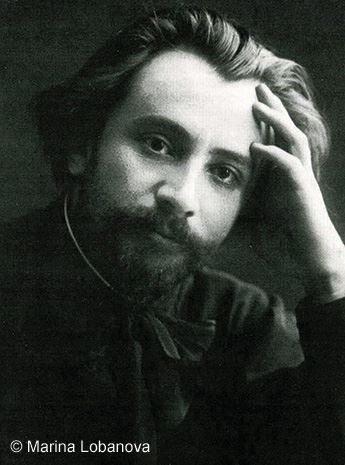 The composer, violinist and teacher Nikolai Roslavets was born in Central Ukraine and studied at the Moscow Conservatory, where his teachers included Ippolitov-Ivanov and the violinist Hrímalý. He graduated with a composition based on Byron’s Heaven and Earth and embarked, with the help of his parents-in-law, on a career as a free-lance composer and music critic. He collaborated with other leading young composers, including Myaskovsky, in the foundation of a group that in 1923 was to become the Association for Contemporary Music. After the February Revolution of 1917 he joined the Socialist Revolutionary Party, and in 1918 was a member of a group affiliated to the Bolsheviks, breaking off his connection in 1921. He did much in the following years to promote the cause of contemporary music, notably as a leader of the Association for Contemporary Music, while defending traditional musical training and earning the condemnation of the Association of Proletarian Musicians, who stigmatized him as a formalist, class enemy, Trotskyite and anti-Soviet. In 1931 he moved from Moscow to Tashkent, where he worked as a conductor, composer and director at the Music Theatre. Two years later he returned to Moscow, where he had difficulty in keeping body and soul together, proscribed by the Soviet authorities, but was teaching privately. At his death in 1944 many of his manuscripts were seized by the secret police, but others were preserved by his widow and by one of his pupils. Perestroika has allowed a revival of interest in his work.
The composer, violinist and teacher Nikolai Roslavets was born in Central Ukraine and studied at the Moscow Conservatory, where his teachers included Ippolitov-Ivanov and the violinist Hrímalý. He graduated with a composition based on Byron’s Heaven and Earth and embarked, with the help of his parents-in-law, on a career as a free-lance composer and music critic. He collaborated with other leading young composers, including Myaskovsky, in the foundation of a group that in 1923 was to become the Association for Contemporary Music. After the February Revolution of 1917 he joined the Socialist Revolutionary Party, and in 1918 was a member of a group affiliated to the Bolsheviks, breaking off his connection in 1921. He did much in the following years to promote the cause of contemporary music, notably as a leader of the Association for Contemporary Music, while defending traditional musical training and earning the condemnation of the Association of Proletarian Musicians, who stigmatized him as a formalist, class enemy, Trotskyite and anti-Soviet. In 1931 he moved from Moscow to Tashkent, where he worked as a conductor, composer and director at the Music Theatre. Two years later he returned to Moscow, where he had difficulty in keeping body and soul together, proscribed by the Soviet authorities, but was teaching privately. At his death in 1944 many of his manuscripts were seized by the secret police, but others were preserved by his widow and by one of his pupils. Perestroika has allowed a revival of interest in his work. 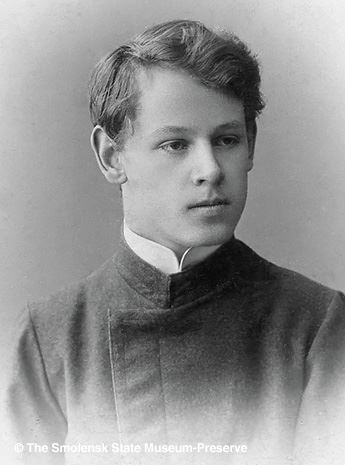 A pupil of Zhilayev and Taneyev at the Moscow Conservatory, Stanchinsky later destroyed many of his earlier compositions, while composing only intermittently during the final years of his short life. Influenced at first by Mussorgsky and then by Skryabin, he left a series of interesting and experimental piano compositions that promised much.
A pupil of Zhilayev and Taneyev at the Moscow Conservatory, Stanchinsky later destroyed many of his earlier compositions, while composing only intermittently during the final years of his short life. Influenced at first by Mussorgsky and then by Skryabin, he left a series of interesting and experimental piano compositions that promised much. Reviews

“…this is an obligatory buy, especially for the overlooked Stranchinsky, and in all performed by pianists who believe in this music and offered brilliantly engineered recordings. The booklets in the box are highly informative… colourfully presented.” – Musical Opinion

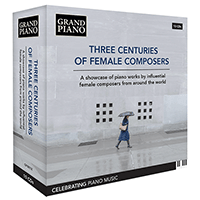
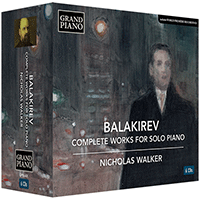
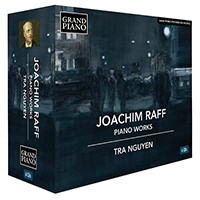
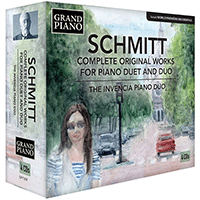
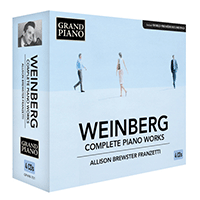
 Grand Piano has gained a reputation for producing high quality recordings of rare keyboard gems. Dedicated to the exploration of undiscovered piano repertoire, the label specialises in complete cycles of piano works by many lesser-known composers, whose output might otherwise have remained unknown and unrecorded.
Grand Piano has gained a reputation for producing high quality recordings of rare keyboard gems. Dedicated to the exploration of undiscovered piano repertoire, the label specialises in complete cycles of piano works by many lesser-known composers, whose output might otherwise have remained unknown and unrecorded.






